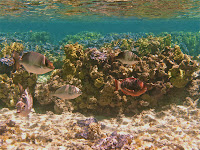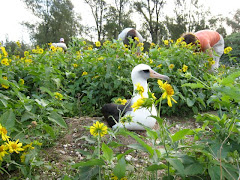

REFLECTIONS 3
Reflections on PA'A
by Robin Craig
from Waikiki, July 2, 2010
Before I was selected to participate in PA'A, I had devoted a large percentage of my law writing career to the issues of marine protection and to adaptation to climate change. Quite frankly, focusing on these two areas is often depressing--but they share the feature of being two legal areas desperately in need of more attention, and more hope. I found that hope at the Midway Atoll, located toward the far end of the Papahanaumokuakea Marine National Monument.
Three images of Midway remain iconic for me (only two of which I could adequately capture by camera). First and second were the abundance of life. While moli (albatross) chicks shared almost every aspect of our outdoor existence, the memory of birds that stays with me the most is that of the multitude of birds in flight over the islands that make up the Atoll, both Sand Island and Eastern Island. Terns, albatross, tropicbirds, and frigate birds played in the sky in unbelievable numbers, with terns and tropicbirds in particular often descending to near-earth to examine the humans walking and biking in what was clearly their domain.
A number of scientists, such as Jeremy B.C. Jackson, have tried to re-create a sense of the historic baseline of species concentrations in various ecosystems. They describe thick beds of oysters in New England and the Chesapeake Bay, turtles so numerous in the Caribbean that sailors could walk on their backs, clouds of birds so large that they could darken the skies. Only on Midway, however, have I personally experienced a true sense of what those kinds of concentration of life truly could be.
Equally important, however, was the relative ease with which those of us on the island could live with that life. Of course, there weren't many of us there (around 80, I believe), and our transportation was limited to feet and bikes most of the time, suggesting the potential value of population reductions and a less oil-dependent lifestyle elsewhere. It was amazing to me how quickly I got used to dodging moli chicks on my bike, and how much I welcomed the examination by the white terns, even though I understood that such examination generally meant that I was too near their nest or egg for their comfort.
The second image of this abundance came in the water, when we snorkeled the Atoll reef. The picture I've included conveys just a small sense of the amount and variety of life on that reef. With over 50% apex predators, these waters again convey a sense of how biodiversity-rich these ecosystems are "supposed" to be.
At the same time, however, Midway did not allow me to romanticize the struggle for survival that typifies most marine ecosystems, or to ignore the damaging legacy of human development and consumption. Plastic littered all beaches on Midway, in an amazing variety, from all over the Pacific. In 15 minutes one morning I gathered 18 fishing floats that appeared (from the writing on them) to be from at least four countries. Moreover, I was ignoring all the other plastic and glass trash I encountered, ranging from an assortment of cigarette lighters to whiskey and sake bottles.
In addition, dead and dying moli chicks were a regular encounter. Saddest for me were the living chicks with "droop wing," a deterioration of the flight muscles resulting from lead poisoning, the enduring legacy of the lead paint used on many of Midway's buildings during the war years. To watch these chicks struggle to move their wings, knowing that they had no hope of survival, was heart-wrenching, especially when I allowed myself to wonder how many would have made it but for the paint chips. Lead remediation efforts are in progress, and hopefully they will remove this toxic invasion from this living landscape.
Nevertheless, evidence of life's resiliency was also everywhere. For me, the most iconic image of Midway--and the one that is coming to stand in my mind for the whole worldwide struggle to preserve and enhance ocean biodiversity and overall health--is the lone endangered monk seal sleeping on the beach among the rusting metal hulks discarded by the military at Rusty Bucket. If these endangered marine mammals can make some kind of peace with Rusty Bucket, then perhaps there really IS hope for the oceans--and for the humans who depend on them--after all.

















No comments:
Post a Comment